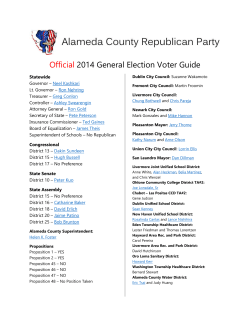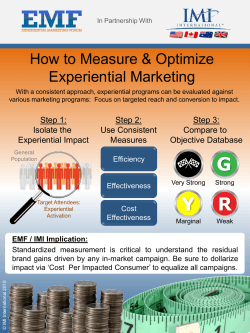
Propositional Logic
Propositional Logic
Section 1.1
1
Definition
A proposition is a declarative
sentence that is either true or false
but not both nor neither
Any proposition has a truth value
{T, F}
2
Examples
Statement
Today is Friday
Prop
yes
Truth
Value
F
1+1 = 2
I know that you hate this course
Is that correct?
Do not answer quickly
I’m a liar
X+ 2 = 0
3
Examples
Statement
Today is Friday
1+1 = 2
I know that you hate this course
Is that correct?
Do not answer quickly
I’m a liar
X+ 2 = 0
Prop
Yes
Yes
Yes
No
No
No
No
Truth
Value
F
T
T
4
Proposition Types
A proposition could be either simple or
compound.
Simple: without logical operators
Compound: with logical operators
(connectives)
5
Logical Operators
Let p & q be propositions, then the
following are compound propositions:
Negation of p: ¬p
= not p
Conjunction:
p∧q
= p AND q
Disjunction:
p∨q
= p OR q
Exclusive OR: p ⊕ q
= p XOR q
Implication:
p → q = if p then q
Biconditional:
p ↔ q = p iff q
6
Negation
p = It is raining
¬ p = It is not raining
= it is not the case that it is raining
Truth table
P
T
F
¬p
F
T
7
Conjunction
p = it is Friday
q = it is raining
p ∧ q = it is Friday and it is raining
Truth Table:
p
T
T
q
T
F
p∧q
T
F
F
T
F
F
F
F
8
Disjunction
p = 1> 0
q = monkeys can fly
p v q = 1>0 or monkeys can fly
Truth Table:
p
T
T
F
F
q
T
F
T
F
pvq
T
T
T
F
9
Conditional Statement: Implication
p = I think
q = I exist
p → q = if I think then I exist
Truth Table:
p
T
T
F
F
q
T
F
T
F
p→q
T
F
T
T
10
If p, then q
p = hypothesis
q = conclusion (consequence)
There are many ways to write a
conditional statement
11
Other Rephrasing of Implication
If p, then q
If p, q
q if p
p is sufficient for q
a sufficient condition for q is p
a necessary condition for p is q
in order to have p true, q has to be true also
q when p
12
Other Rephrasing of Implication
p→q
p implies q
p only if q
p is true only if q is also true
q follows from p
13
Examples of Implication
If you get 98% then I’ll give you A+
98% is sufficient for A+
If you get A+ then it doesn’t mean you have
98%
A+ is necessary for 98%
98% however is not necessary for A+
98% only if A+
A+ follows from 98%
98% doesn’t follow from A+
14
Examples of Implication
Notice that if p is true then q must be
true, however if p is not true then q may
or may not be true.
15
Examples of Implication
ﺳﻮرة اﻷﻧﺒﻴﺎء 68 - 59
ﻦ
ﻦ اﻟﻈﱠﺎِﻟﻤِﻴ َ
ﻞ َهﺬَا ﺑِﺂِﻟ َﻬ ِﺘﻨَﺎ ِإﻧﱠ ُﻪ َﻟ ِﻤ َ
) (59ﻗَﺎﻟُﻮا ﻣَﻦ َﻓ َﻌ َ
ل َﻟ ُﻪ ِإ ْﺑﺮَاهِﻴ ُﻢ
ﺳ ِﻤ ْﻌﻨَﺎ َﻓﺘًﻰ َﻳ ْﺬ ُآ ُﺮ ُه ْﻢ ُﻳﻘَﺎ ُ
) (60ﻗَﺎﻟُﻮا َ
ن
ﺸ َﻬﺪُو َ
س َﻟ َﻌﱠﻠ ُﻬ ْﻢ َﻳ ْ
ﻦ اﻟﻨﱠﺎ ِ
ﻋ ُﻴ ِ
ﻋﻠَﻰ َأ ْ
) (61ﻗَﺎﻟُﻮا َﻓ ْﺄﺗُﻮا ِﺑ ِﻪ َ
ﺖ َهﺬَا ﺑِﺂِﻟ َﻬ ِﺘﻨَﺎ ﻳَﺎ ِإ ْﺑﺮَاهِﻴ ُﻢ
ﺖ َﻓ َﻌ ْﻠ َ
) (62ﻗَﺎﻟُﻮا َأأَﻧ َ
ن
ﻄﻘُﻮ َ
ﺳَﺄﻟُﻮ ُه ْﻢ إِن آَﺎﻧُﻮا ﻳَﻨ ِ
ﻞ َﻓ َﻌَﻠ ُﻪ َآﺒِﻴ ُﺮ ُه ْﻢ َهﺬَا ﻓَﺎ ْ
ل َﺑ ْ
) (63ﻗَﺎ َ
ن
ﺴ ِﻬ ْﻢ َﻓﻘَﺎﻟُﻮا ِإ ﱠﻧ ُﻜ ْﻢ أَﻧ ُﺘ ُﻢ اﻟﻈﱠﺎِﻟﻤُﻮ َ
ﺟﻌُﻮا ِإﻟَﻰ أَﻧ ُﻔ ِ
)َ (64ﻓ َﺮ َ
ﻋِﻠ ْﻤ َ
ﺳ ِﻬ ْﻢ َﻟ َﻘ ْﺪ َ
ن
ﻄﻘُﻮ َ
ﺖ ﻣَﺎ َه ُﺆﻟَﺎء َﻳﻨ ِ
ﻋﻠَﻰ ُرؤُو ِ
)ُ (65ﺛﻢﱠ ُﻧ ِﻜﺴُﻮا َ
ﻀﺮﱡ ُآ ْﻢ
ﺷ ْﻴﺌًﺎ َوﻟَﺎ َﻳ ُ
ن اﻟﱠﻠ ِﻪ ﻣَﺎ ﻟَﺎ ﻳَﻨ َﻔ ُﻌ ُﻜ ْﻢ َ
ن ﻣِﻦ دُو ِ
ل َأ َﻓ َﺘ ْﻌ ُﺒﺪُو َ
) (66ﻗَﺎ َ
ن
ن اﻟﱠﻠ ِﻪ َأ َﻓﻠَﺎ َﺗ ْﻌ ِﻘﻠُﻮ َ
ن ﻣِﻦ دُو ِ
)ُ (67أفﱟ ﱠﻟ ُﻜ ْﻢ َوِﻟﻤَﺎ َﺗ ْﻌ ُﺒﺪُو َ
ﻦ
ﻋﻠِﻴ َ
ﺼﺮُوا ﺁِﻟ َﻬ َﺘ ُﻜ ْﻢ إِن آُﻨ ُﺘ ْﻢ ﻓَﺎ ِ
ﺣ ﱢﺮﻗُﻮ ُﻩ وَاﻧ ُ
) (68ﻗَﺎﻟُﻮا َ
16
Examples of Implication
68 - 59 ﺳﻮرة اﻷﻧﺒﻴﺎء
It is very clear that the prophet Ebrahim
didn’t lie because he said that
If they speak, then the biggest one did it
17
BiConditional Statement
p=1<0
q = monkeys can fly
p ↔ q = 1< 0 if and only if monkeys can fly
Truth Table:
p
T
T
F
F
q
T
F
T
F
p↔q
T
F
F
T
18
BiConditional Statement
p ↔ q = p if and only if q
= p if q and p only if q
= “q → p” and “p → q”
= “p → q” ∧ “q → p”
p is necessary & sufficient for q
p and q always have the same truth
value
19
Theorem
p and q are logically equivalent, i.e.,
p ≡ q if and only if p ↔ q is always true
p
T
T
F
F
q
T
F
T
F
p≡q
T
F
F
T
p↔q
T
F
F
T
20
Logically equivalent
¬p v q ≡ p → q
Example
p
q
¬p
¬p v q
p→q
T
T
F
T
T
T
F
F
F
F
F
T
T
T
T
F
F
T
T
T
21
Precedence of Logical Operators
The following operators are sorted according to
their precedence
¬,∧ ,v ,→ ,↔
This means for example
(((p∧(¬q)) v p v q ) → q) ↔ ( (p∧(¬q)) v p)
22
© Copyright 2025













